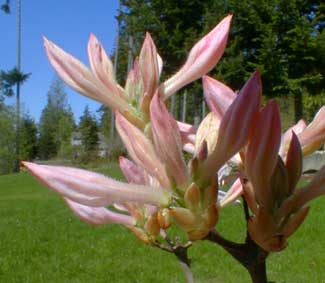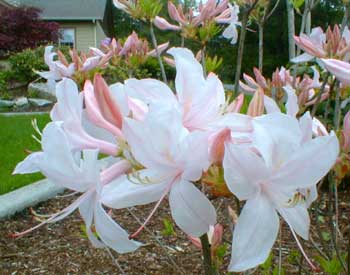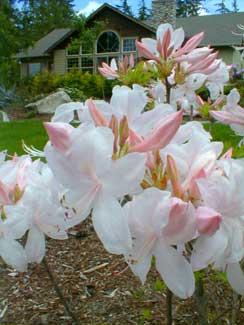
'White Lights'
Deciduous Azalea
"When the white azaleas start blooming
Up in those mountains so high
We'll build a nest where we'll find happiness
Sweetheart for only you & I."
-George Morgan
(1924-1975)
(1924-1975)
This 1984 introduction is one of the "Northern Lights" series which can be grown further north than most azaleas, though the extreme cold-hardiness of shrubs like 'White Lights' is scarceley tested in the mild Northwest winters.
The buds for 'White Lights' can withstand temperatures as low as minus 35 degrees F., so is practical for USDA zones 4 through 8, & might be stretched to zones 3 through 9.
 When there is a cold-snap in our mild region, the "Northern Lights" series are definitely not in that group of shrubs we need to worry about or rush out to wrap against the cold, as our nastiest winters of record are a hot day at the beech compared to Minnesota, where the Lights series was developed.
When there is a cold-snap in our mild region, the "Northern Lights" series are definitely not in that group of shrubs we need to worry about or rush out to wrap against the cold, as our nastiest winters of record are a hot day at the beech compared to Minnesota, where the Lights series was developed.These hardy hybrids were developed at the University of Minnesota under the guidance of Harold Pellett, head of the Pellett Experiment Station beginning 1978.
Although retired from the Station in 2004, he continues his signal work with azaleas & other woody shrubs, as executive director of the Landscape Plant Development Center at the Minnesota Landscape Arboretum.
About mid-April, numerous pale pink buds are showy even before they become open flowers toward month's end & for May.
 These slender-pillow pink buds for 'White Lights' open into racemes of medium-sized funnels, white with salmon pink highlights, quickly aging to a purer white.
These slender-pillow pink buds for 'White Lights' open into racemes of medium-sized funnels, white with salmon pink highlights, quickly aging to a purer white.The shrub is very floriferous; the trusses of four or five funnels possess an excellent scent. It's a smallish cultivar with a ten-year height of five or six feet. Flowers precede the leaves & are still present when the leaves are in.
The "Lights" series additionally provides excellent autumn leaf colors, which is almost like a second yearly bloom period. The autumn colors for 'White Lights' tend toward purples. The upright, well-branching, twiggy structure is attractive even leafless in winter.
It was bred from the much larger pink-flowering Rhododendron prinophyllum (formerly R. roseum), a shrub native to Missouri, New England, the Virginias & Texas. It was pollinated by an unnamed white-flowering Exbury hybrid to arrive at 'White Lights.'
Other shrubs in the Lights series bred from the same species include 'Spicy Lights,' 'Pink Lights,' 'Northern Hi-Lights,' 'Apricot Surprise,' 'Golden Lights' & 'Rosey Lights,' plus cultivars from other breeders including a number from Frank Abbott. R. prinophyllum is such a popular choice for hybridizing because it lends hardiness & a pleasing clove scent to its offspring.
'White Lights' likes full sun to partial or filtered sunlight. Persistant moisture in well drained soil is best; you can tell by wilting leaves if it gets thirsty, & those unhappy leaves generally bounce back immediately when watered.